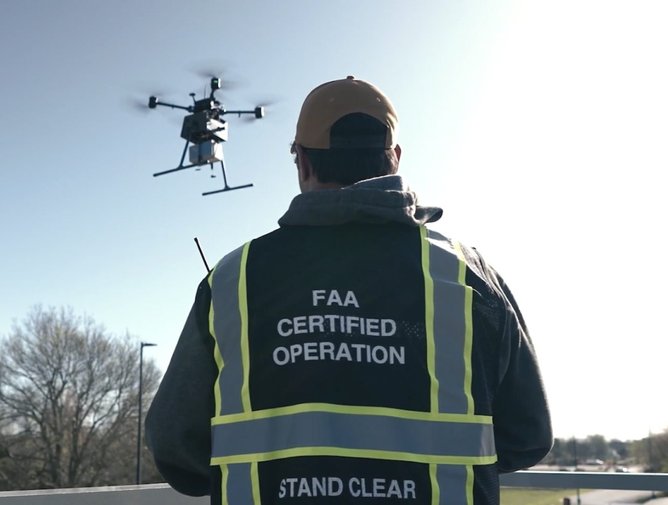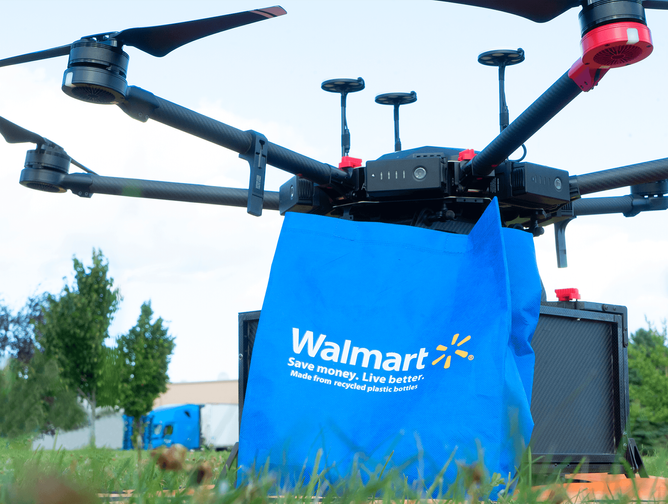Walmart: Reducing Emissions With Drone Delivery Technology

It was a decade ago during an airing of '60 Minutes' when Amazon’s Jeff Bezos introduced to the world the Autonomous Delivery Drone – an innovation he declared would become as common as mail trucks by 2018.
While his prediction hasn’t quite panned out, more and more companies – from logistics firms (FedEx and DHL) to retail giants (Amazon and Walmart) – are turning to drones to deliver packages to customers.
As unmanned aerial vehicles that drive remotely and autonomously on electric power, drones have multiple benefits over courier trucks – they are faster, cheaper, more efficient, and crucially – more environmentally friendly.
Amazon is expanding its drone deliveries beyond the US for the first time, rolling out its Prime Air service in the UK and Italy by the end of 2024; while Walmart, which claims to have completed more than 20,000 drone-based deliveries since first taking to the skies two years ago, is taking its drone service to new heights.
“Drone delivery is not just a concept of the future, it’s happening now...”, Prathibha Rajashekhar, Walmart’s US Senior Vice President of Innovation and Automation said during recently-held tech show CES 2024 – where the multinational retail giant unveiled its largest-ever drone delivery expansion.
Announcing expansion of its drone delivery service to up to 1.8 million additional homes – 75% of the Dallas, Fort-Worth population – the world's biggest retailer with 10,500 stores and clubs in 19 countries and 2.1 million Associates now serves seven states by drone delivery across the US.
This marks the largest drone delivery expansion of any US retailer and means Walmart has the largest drone delivery footprint of any US retailer.
“If this milestone is any indication, we believe 2024 is the year of drone delivery,” said Adam Woodworth, CEO of drone delivery startup Wing, which is owned by Google and provides the drones to Walmart.
How Walmart is decarbonising transportation
For Walmart, using drones to deliver brings multiple benefits to customers (convenience and speed), to Walmart (cost-saving, safe, zero emissions) – and ultimately to the planet.
As the world’s biggest retailer, Walmart operates one of the largest fleets in the US, with 12,000 drivers, 10,000 tractors and 80,000 trailers driving 1.1 billion miles every year.
With a fleet of such scale, it makes up around 24% of Scope 1 emissions in 2020.
No wonder then that the big box retailer is exploring all options as it looks to tackle carbon emissions in its logistics operations and supply chains.
Walmart has set goals to decarbonise its operations and expand access to clean energy for customers and suppliers by 2040 – and is employing numerous strategies; from adding more onsite renewable energy sources like solar panels to facilities, to moving beyond fossil fuels with alternative fuels and transportation options for its fleets.
Having already decreased its Scope 1 and 2 emissions by 23.2% through 2021 and increased the percentage of electricity supplied by renewable sources to 46%, the retail giant is on track to reach its goals, which includes:
- Powering Walmart facilities with 100% renewable energy by 2035
- Zeroing out emissions from all vehicles, including long-haul trucks by 2040
Among the first to use 100% electric self-driving cars and class 3 trucks, electric delivery vans, Walmart has pledged to convert its entire fleet of vehicles to EVs by 2030.

The company is also testing alternative fuel-types in its transportation fleet, from renewable natural gas to hydrogen – becoming the first transportation company to receive Cummins’ new 15-litre Natural Gas Engine in 2023.
Last-mile delivery is a particular focus for the company, given not just the challenges and environmental damage it poses, but the opportunities for innovation in this area.
Globally, the last mile accounts for up to 50% of total delivery carbon emissions – that’s 7 million tonnes of CO2 in Europe and the US combined – so tackling this area is a priority.
Walmart is already using AI technology to better coordinate delivery of orders by matching store locations with customer delivery destinations – leading to fewer miles driven from delivery; and is leading the charge on building its own EV fast-charging network at thousands of Walmart locations, helping reduce emissions for customers.
Complementing this, the retailer's delivery drone service is taking off – promising a very real replacement for trucks, cars and scooters in last-mile delivery.
Walmart began its drone delivery programme with Zipline and DroneUp in its home state of Arkansas in 2021, later expanding it to further states in 2022.
Now, the retailer is working with Google startup Wing Aviation too, with Wing and Zipline both approved by the FAA to fly drones “without dedicated observer being able to see the drone at all times”.

Walmart: using drone deliveries as decarbonisation strategy
Wing’s drones weigh 400 times less than the average car, and typically make deliveries in less than a third of the time than other modes of delivery. They also run on electric.
Recent studies suggest Wing’s drones generate 94% lower emissions than deliveries by car.
Drone deliveries take from 10 to 30 minutes, says Walmart’s Rajashekhar, with 75% of the 120,000 items in the retailer meeting the size and weight requirements for a drone delivery.
Apart from the obvious (cheaper, quicker, easier access), for Walmart, drone delivery means less trucks on the road (less traffic, fewer accidents and less emissions). It’s a way to replace those impromptu trips by customers to the grocery store, given that 43% of consumers say last-minute grocery runs are their most common reason for an unplanned car trip.
A recent study by Virginia Tech explored the potential benefits of drone delivery in three metropolitan areas across the US and found that in a single city, this method could not only reduce rod travel by up to 294 million miles per year and help to avoid 580 accidents, but reduce emissions equivalent to more than 46,000 acres of new forest in each service area.
Drones also consume less energy, thanks to their lightweight design, and because they can be charged using renewable energy sources.
According to the world’s largest autonomous delivery company Zipline, which operates on four continents and works with Walmart, drone delivery with Zipline’s next-generation technology is “7x as fast, zero emissions and whisper quiet”, says Keller Rinaudo Cliffton, CEO.
And with nearly 4,700 stores located within 10 miles of 90% of the US population, Walmart is uniquely positioned to scale this technology as a solution to carbon emission-heavy last-mile delivery.
“Autonomous delivery is finally ready for national scale in the US”, says Cliffton.
The future of drone delivery in last-mile delivery looks ripe for the taking. Drone delivery has grown into an estimated US$2.8 billion market, and is expected to reach US$16.3 billion by the end of the decade.

So, what other companies are tapping this technology:
- Amazon – Prime Air drone delivery system – Through its Prime Air drone delivery system, Amazon has been safely delivering packages weighing up to five pounds in two US cities (Texas and California), for almost a year. And in October 2023, announced expansion of the service to a third US city and to overseas locations – with plans to roll out the service in the UK and Italy by the end of 2024. Drone deliveries will also be integrated into Amazon’s delivery network, to be deployed from Same-Day Delivery sites.
- UPS Flight Forward – First receiving government approval to operate its drone service in 2019, UPS first focused on building a drone delivery network for US hospital campuses, operating the first-ever US drone Covid-19 vaccine delivery. Since September 2023, UPS has been granted permission by the FAA to fly longer distance flights – which means UPS Flight Forward (a UPS subsidiary focused on drone delivery) can now deliver small packages beyond the visual line of sight.
- Walmart and Tide Campaign: Why Cold-Water Laundry is BestSustainability
- Sustainability LIVE: Net Zero – The Scope 3 ForumNet Zero
- H&M Group Prioritises Sustainable Sourcing to Hit TargetsSupply Chain Sustainability
- NIKE Aims Higher After Hitting Some Carbon-Reduction TargetsSustainability






